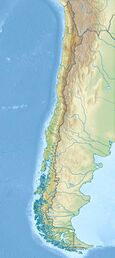Earth:Lauca (volcano)
| Lauca | |
|---|---|
| Highest point | |
| Elevation | 5,140 m (16,860 ft) [1] |
| Coordinates | [ ⚑ ] : 18°20′S 69°23′W / 18.333°S 69.383°W [2] |
| Naming | |
| English translation | Aquatic grass |
| Language of name | Aymara |
| Geography | |
| Location | Putre, Arica y Parinacota Region |
| Parent range | Altiplano, Andes |
| Geology | |
| Age of rock | Miocene-Pliocene |
| Mountain type | Stratovolcano |
| Volcanic belt | Central Volcanic Zone |
| Last eruption | Pliocene |
Lauca is a 5,140 metres (16,860 ft)[1] high andesitic stratovolcano in the Central Volcanic Zone of the Andes on the Altiplano in northern Chile . Administratively it is located in Putre, Arica y Parinacota Region. The volcano was active during the Late Miocene from 10.5 million years ago onwards. A major ignimbrite collapsed the volcano in the Late Pliocene.
Geology
Andesites from the Lauca volcano, active in the Late Miocene as of 10.5 million years ago,[3] exist in two groups, plagioclase rich ones which underwent alteration and fine grained silicic ones that are fresher.[1] The territory is underpinned with a crust formed from rocks of Precambrian to Cretaceous age, with thicknesses up to 70 kilometres (43 mi).[2] Amphibole rich lava flows formed a uniform volcanic cone. A later major ignimbrite eruption caused the collapse of the centre and formed the Lauca ignimbrite.[1] A caldera is present, with a lava dome at the northeastern rim.[1]
The Lauca ignimbrite has a thickness up to 150 metres (490 ft), covering the El Diablo Formation in parts and filling the Lluta Canyon. Ar-Ar ages for this rhyolitic ignimbrite have been determined at 2.73 ± 0.02 Ma based on sanidine analysis and 2.87 ± 0.05 Ma from biotite.[4] The Lauca ignimbrite has been correlated to the Pérez ignimbrite in Bolivia and the Pachía ignimbrite in southern Peru.[5] Along the Copaquilla-Tignámar Fault, uplifting the eastern side over the western side,[6] the Lauca ignimbrite has been displaced over 100 to 150 metres (330 to 490 ft), indicative of tectonic activity after deposition in the Late Pliocene.[7] In parts, the Lauca ignimbrite is covered by conglomeratic terrace deposits.[8]
See also
- Caldera Lauca
- Lauca National Park
- Lauca River
- Lake Tauca
References
Bibliography
- Charrier, Reynaldo; Hérail, Gérard; Pinto, Luisa; García, Marcelo; Riquelme, Ricardo; Farías, Marcelo; Muñoz, Nelson (2013). "Cenozoic tectonic evolution in the Central Andes in northern Chile and west central Bolivia: implications for paleogeographic, magmatic and mountain building evolution". International Journal of Earth Sciences 102 (1): 235–264. doi:10.1007/s00531-012-0801-4. Bibcode: 2013IJEaS.102..235C.
- García, Marcelo; Riquelme, Rodrigo; Farías, Marcelo; Hérail, Gérard; Charrier, Reynaldo (2011). "Late Miocene–Holocene canyon incision in the western Altiplano, northern Chile: tectonic or climatic forcing?". Journal of the Geological Society, London 168 (4): 1047–1060. doi:10.1144/0016-76492010-134.
- Kött, A.; Gaupp, R.; Wörner, G. (December 1995). "Miocene to recent history of the western Altiplano in northern Chile revealed by lacustrine sediments of the Lauca basin (18°15'-18°40'S/69°30'-69°05'W)". Geologische Rundschau 84 (4): 770. doi:10.1007/BF00240567. Bibcode: 1995GeoRu..84..770K.
- Schlunegger, Fritz; Kober, Florian; Zeilinger, Gerold; Von Rotz, Ruedi (2010). "Sedimentology-based reconstructions of paleoclimate changes in the Central Andes in response to the uplift of the Andes, Arica region between 19 and 21S latitude, northern Chile". International Journal of Earth Sciences 99: S123–S137. doi:10.1007/s00531-010-0572-8. https://boris.unibe.ch/6523/8/531_2010_Article_572.pdf.
- Wigger, edited by Klaus-Joachim Reutter, Ekkehard Scheuber, Peter J. (2012). "volcan+lauca"&pg=PA81 Tectonics of the Southern Central Andes Structure and Evolution of an Active Continental Margin. Berlin, Heidelberg: Springer Berlin Heidelberg. pp. 1–334. ISBN 978-3-642-77353-2. https://books.google.com/books?id=R3f1CAAAQBAJ&dq="volcan+lauca"&pg=PA81. Retrieved 21 March 2017.
- Wörner, Gerhardt; Lopez Escobar, Leopoldo; Moorbath, Stephen; Horn, Susan; Entenmann, Jürgen; Harmon, Russel S.; Davidson, Jon D. (1992). "Variaciones geoquimicas, locales y regionales, en el frente volcanico cuaternario de los Andes centrales (17°30'-22°00'S), norte de Chile" (in es). Andean Geology 19 (1). Archived from the original on 22 March 2017. https://web.archive.org/web/20170322111817/http://www.andeangeology.cl/index.php/revista1/article/view/1372. Retrieved 21 March 2017.


